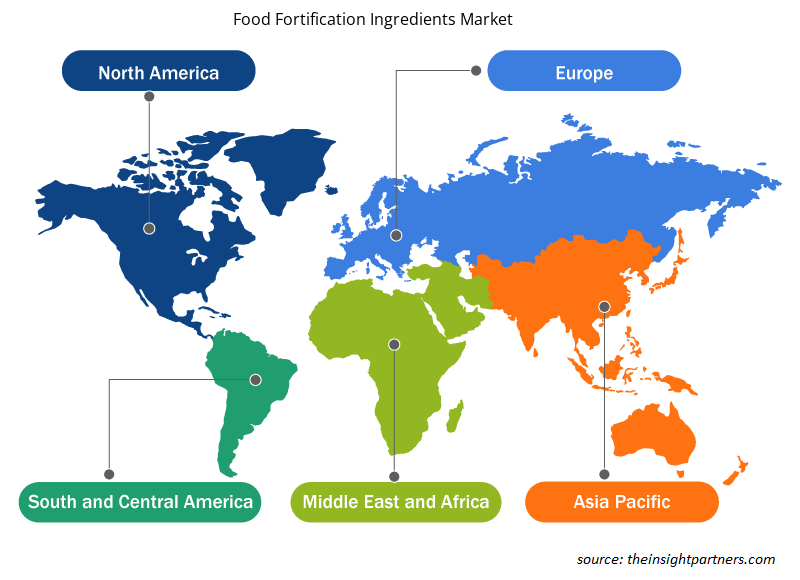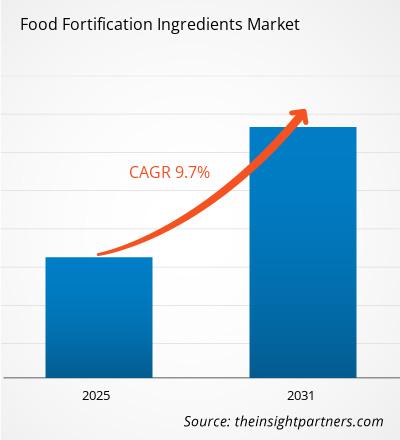食品强化成分市场预计在 2024 年至 2031 年期间的复合年增长率为 9.7%,市场规模将从 2024 年的 XX 百万美元扩大到 2031 年的 XX 百万美元。
食品强化成分市场报告涵盖了按类型(矿物质、维生素、蛋白质和氨基酸、益生菌等)、应用(早餐谷物、乳制品和冷冻甜点、饮料、脂肪和油、婴儿配方奶粉等)和地理(北美、欧洲、亚太地区以及南美和中美洲)进行的分析。全球分析进一步细分为区域和主要国家。报告以美元为单位提供了上述分析和细分的价值。
报告目的
The Insight Partners 发布的《食品强化成分市场》报告旨在描述当前形势和未来增长、主要驱动因素、挑战和机遇。这将为各种业务利益相关者提供见解,例如:
- 技术提供商/制造商:了解不断变化的市场动态并了解潜在的增长机会,从而能够做出明智的战略决策。
- 投资者:对市场增长率、市场财务预测以及整个价值链中存在的机会进行全面的趋势分析。
- 监管机构:监管市场政策和警察活动,旨在最大限度地减少滥用行为,维护投资者的信任和信心,维护市场的完整性和稳定性。
食品强化成分市场细分
类型
- 矿物质
- 维生素
- 蛋白质和氨基酸
- 益生菌
- 其他的
应用
- 早餐谷物
- 乳制品和冷冻甜点
- 饮料
- 油脂
- 婴儿配方奶粉
定制此报告以满足您的需求
您可以免费定制任何报告,包括本报告的部分内容、国家级分析、Excel 数据包,以及为初创企业和大学提供优惠和折扣
- 获取此报告的关键市场趋势。这个免费样品将包括数据分析,从市场趋势到估计和预测。
食品强化成分市场增长动力
- 营养不良意识:营养不良意识的增强以及维生素和矿物质缺乏症的增加推动了市场的发展。政府通过食品强化的举措也刺激了人们的采用,市场趋势越来越多地引入大米和面粉等主食。
- 强化饮料需求上升:随着人们健康意识的增强,强化饮料和零食越来越受欢迎,从而扩大了市场规模。通过 PEST 分析,我们将讨论监管框架和消费者行为如何影响强化成分市场。
- 先进技术:改进的封装和稳定技术促进了强化成分的更广泛应用,从而增强了竞争格局。报告强调这些发展是满足全球市场需求的手段。
食品强化成分市场未来趋势
- 微量营养素强化:随着人们健康意识的增强,富含铁、锌和维生素的强化食品占据主导地位。主要参与者专注于强化面粉和盐等日常主食。
- 政府举措:补贴和强化要求推动了发展中地区的增长,并在 SWOT 分析中强调了这些机遇。
- 植物基革命:纯素强化成分,如藻类衍生的 Omega-3,重新定义产品组合,影响长期市场战略
食品强化成分市场机会
- 产品创新:随着消费者越来越注重健康,对强化食品的需求也日益增长。这一趋势为公司提供了机会,可以开发针对特定健康益处的创新强化成分,从而提高其在北美和欧洲的市场份额。
- 发展中国家食品强化计划的增长:在许多发展中国家,政府正在投资食品强化计划,以解决微量营养素缺乏问题。制造商可以利用这一增长机会,提供强化成分,从而为全球健康改善做出贡献,同时扩大其在这些新兴市场的影响力。
- 对健康产品的需求不断增长:由于消费者需要更健康的饮料、零食和补品,食品强化成分市场提供了巨大的多样化机会。制造商可以探索非传统食品的强化,以在包括北美和亚洲在内的不同地区提供增长机会。
食品强化成分市场区域洞察
Insight Partners 的分析师已详尽解释了预测期内影响食品强化成分市场的区域趋势和因素。本节还讨论了北美、欧洲、亚太地区、中东和非洲以及南美和中美洲的食品强化成分市场细分和地理位置。

- 获取食品强化成分市场的区域特定数据
食品强化成分市场报告范围
| 报告属性 | 细节 |
|---|---|
| 2024 年的市场规模 | XX 百万美元 |
| 2031 年市场规模 | XX 百万美元 |
| 全球复合年增长率(2025 - 2031) | 9.7% |
| 史料 | 2021-2023 |
| 预测期 | 2025-2031 |
| 涵盖的领域 | 按类型
|
| 覆盖地区和国家 | 北美
|
| 市场领导者和主要公司简介 |
|
食品强化成分市场参与者密度:了解其对业务动态的影响
食品强化配料市场正在快速增长,这得益于终端用户需求的不断增长,而这些需求又源于消费者偏好的不断变化、技术进步以及对产品优势的认识不断提高等因素。随着需求的增加,企业正在扩大其产品范围,进行创新以满足消费者的需求,并利用新兴趋势,从而进一步推动市场增长。
市场参与者密度是指在特定市场或行业内运营的企业或公司的分布情况。它表明在给定市场空间中,相对于其规模或总市场价值,有多少竞争对手(市场参与者)存在。
在食品强化成分市场运营的主要公司有:
- 荷兰皇家帝斯曼集团
- 嘉吉公司
- 巴斯夫
- 泰特和莱尔
- 阿彻丹尼尔斯米德兰公司
免责声明:上面列出的公司没有按照任何特定顺序排列。

- 获取食品强化成分市场顶级关键参与者概览
主要卖点
- 全面覆盖:报告全面涵盖了食品强化成分市场的产品、服务、类型和最终用户的分析,提供了整体概况。
- 专家分析:报告基于对行业专家和分析师的深入了解而编写。
- 最新信息:该报告涵盖了最新信息和数据趋势,确保了其与业务的相关性。
- 定制选项:此报告可以定制以满足特定客户要求并恰当地适应业务策略。
因此,食品强化成分市场研究报告有助于引领解读和了解行业情景和增长前景。尽管可能存在一些合理的担忧,但本报告的总体优势往往大于劣势。
- 历史分析(2 年)、基准年、预测(7 年)及复合年增长率
- PEST和SWOT分析
- 市场规模、价值/数量 - 全球、区域、国家
- 行业和竞争格局
- Excel 数据集
近期报告
相关报告
客户评价
购买理由
- 明智的决策
- 了解市场动态
- 竞争分析
- 客户洞察
- 市场预测
- 风险规避
- 战略规划
- 投资论证
- 识别新兴市场
- 优化营销策略
- 提升运营效率
- 顺应监管趋势





















 获取免费样品 - 食品强化配料市场
获取免费样品 - 食品强化配料市场